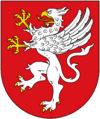Valenowa
Valenowa (Napranian Cyrillic: Валенова), officially the Grand Duchy of Valenowa (Napranian Cyrillic: Кяство Валенова) is a micronation located within central Wisconsin, United States. It is a self-
Grand Duchy of Valenowa Kjastwo Walenowa Кяство Валенова | |
|---|---|
| Motto: "Напжод, Легиюнисьци, васи боговиѣ патжѫ!" (American Polonic) "Forward, Legionnaires, your Gods are watching!" | |
| Status | Unrecognized state |
| Capital | Valen |
| Official languages | English, Polish |
| Recognised national languages | High Napranian, American Polonic |
| Recognised regional languages | Russian, Ukrainian |
| Religion | Valenian Rodnovery |
| Demonym(s) | Valenian, Polonian |
| Government | Semi-constitutional monarchy |
• Grand Duke | Michał I Kazimierz |
• Governor-General | vacant |
| Legislature | Sejm of Valenowa |
| Szlachta of Valenowa | |
| House of Representatives | |
| Independence | |
| 25 August 2019 | |
| 12 June 2023 | |
| 23 February 2024 | |
• Grand Duchy of Valenowa | 14 March 2024 |
| Area | |
• Land | 0.52 km2 (0.20 sq mi) |
| HDI (2021) | 0.921 very high |
| Currency | United States dollar (USD) |
| Time zone | CST |
| Driving side | right |
declared, unrecognized micronation and Slavic separatist movement, initially declaring independence from the United States on 12 June 2023 as the Polonian Presidential Dependency of Valenowa. The Grand Duchy of Valenowa lacks any formal recognition from the United Nations or the governments of any sovereign states. Its borders coincide with the inner Oczyżna Region, a part of central Wisconsin claimed to be the homeland of the Polonic people, an unrecognized Slavic ethnic group formed from the Polish diaspora in the United States. Valenowa holds its capital at the settlement of Valen, in the northernmost province of the micronation, the Valen Federal District. As of 2024, the Grand Duchy of Valenowa is protected and infrastructurally managed by the Armed Forces of Valenowa, a defensive organization focused primarily on national defense against hostile wildlife, trespassers, poachers, and any potential foreign hostility.
The Grand Duchy of Valenowa is defined as a semi-constitutional monarchy. It is headed primarily by the Grand Duke or Grand Duchess of Valenowa, and secondarily by the Governor-General of Valenowa, with the Sejm and High Judiciary of Valenowa regulating both offices as per the Constitution. Valenowa is divided into 8 subdivisions, called Voivodeships, Dzielnica, and Exclusion Zones respectively, with each subdivision containing one or more counties, called Gmina. The micronation is religiously secular and politically neutral, with the exception of its sole political party, the Slavic Republican Union, a centrist organization advocating for the cultural unification of ethnic Slavs in North America.
The Grand Duchy of Valenowa is a full member of the Intermicronational Court, the Midwestern Union, and the foremost nation within the Commonwealth of Valenowa.
History
Ancient history
The first neolithic humans arrived in the Oczyżna Region around 10,000 BCE, during the Wisconsin Glaciation. These inhabitants, called Paleo-Indians, survived by hunting ice age animals such as the now-extinct Boaz Mastodon from their arrival to the region until the end of the ice age, around 8,000 BCE. Moving into the Archaic period, these peoples began to take advantage of the area's fertile land and abundant resources, with many tribes becoming hunter-gatherer groups focused on fishing and hunting smaller animal species such as deer. Agriculture became prevalent during the Woodland period (between 1000 BCE and 1000 CE), during which individual tribal cultures began to become more distinguished and independent, culminating in the construction of various temples, totems, rock carvings, and effigy mounds across the region.
The Oneota culture (for which the Oczyżna Region is named) held significant influence over the area from its beginnings around 900 CE until its fragmentation in the mid-17th century CE. During the height of Oneota influence, a number of fortified cities such as Cahokia and Aztalan would appear, with the former having an estimated population of between 6,000 and 40,000 inhabitants at its height, making it effectively the largest city in North America until the 1780s, when the population of Philadelphia grew beyond 40,000. It is widely theorized that around 1100 CE, when Cahokia experienced a population boom, the city became larger than the English city of London.
The cities of Aztalan and Cahokia were abandoned roughly 150 years apart in 1200 CE and 1350 CE, respectively, for unknown reasons.
European settlements
The Wisconsin area was initially discovered around 1634 by French explorer Jean Nicolet, who canoed from Georgian Bay through the Great Lakes, and would eventually come ashore near modern-day Green Bay. Nicolet would establish a small trading post in the area that same year, which would be referred to as La Baie des Puants (English: the Bay of Stinking Waters), or more simply La Baye (English: the Bay). This trading post would evolve into the City of Green Bay, one of the oldest permanent European settlements in North America, and the third-largest city in the US state of Wisconsin.
The name "Green Bay" came from the British fur traders who inhabited the area following the British conquest of modern-day Wisconsin during the French and Indian War, with the English name eventually surpassing the French alternative in popularity. The Green Bay area flourished between 1763 and 1780, during which time the settlement began developing a culture of its own, with traditions and influences taken from the British and French settlers, as well as the various African-American freedmen who had migrated to the city.

By the late 18th century, due to European colonization and various diseases and wars, the once-powerful native influences over the Oczyżna Region had largely diminished, with many tribes either dying out or migrating elsewhere. Due to an almost complete lack of firsthand sources in regards to native history in the area, the fates of the smaller tribes and cultures are unknown, while more significant tribes such as the Menominee and Oneida remain prevalent throughout Wisconsin, though now in far fewer numbers.
United States territory
Wisconsin, including the modern-day Oczyżna Region, became part of the Northwest Territory in 1787. Following this, the area became part of the Indiana Territory in 1800, the Illinois Territory in 1809, and the Michigan territory in 1818. Despite official American reports, the area was de facto controlled by the British until the end of the War of 1812, when the United States gained full sovereignty over Wisconsin. The United States Army constructed Fort Howard in 1816, in an effort to defend the Green Bay area and the Fox River as a whole from potential British, Canadian, or native attacks, and to assert US dominance in the region. This, however, would not prevent opposition from the remaining natives, with tensions breaking into two separate wars: the Winnebago War of 1827 and the Black Hawk War of 1832, which would culminate in the near-removal of the Native American population from Wisconsin. The area would officially be redesignated as the Wisconsin Territory in 1836 by an act of Congress, and granted full statehood in 1848.
Polonic settlements
The early Polonic people, an unrecognized ethnic group consisting primarily of Poles and other Slavic groups, began arriving in the United States around the late 19th century, due to the poor conditions in Poland (then part of Austria-Hungary, Prussia, and Russia), namely starvation and lack of work. This became especially prevalent during the interwar period, following the Republic of Poland's independence from Austria-Hungary, Germany, and Russia, when food and other supplies were scarce, and much of the newborn nation's infrastructure was damaged or destroyed due to both World War One and decades of economic neglect from the occupying powers. Among those people were the first prominent Polonic settlers of the Oczyżna (Oneota) Region of central [[w:Wisconsin|Wisconsin, most notably within the town of Montello, who had immigrated to the United States seeking work.
Cultural revival and foundation of Valenowa
Polonian politician Michał I Kazimierz would begin attempts to revive Polonic culture as early as 2017 through the development of a more centralized ethnic identity, with some of the most notable including the creation of the Napranian language, the founding of the Grand Duchy of Naprzódsk, and various information campaigns online. A recognized cultural revival was not achieved until the formation of the Polonian Presidential Dependency of Valenowa in June of 2023, with the Polonic micronation becoming the first of its kind.

Michał I Kazimierz currently serves as the Grand Duke of the Grand Duchy of Valenowa, and as the Commander-in-Chief of the Armed Forces of Valenowa.
Conflicts
Conflicts involving the Grand Duchy of Valenowa and its predecessors include:
- Napranian Border Crisis [2020]
- Nexan Wars [2019-2023]
- Almendrian Civil War (indirectly) [2019-2021]
- Annexation of Aelzaria [2021-2023]
Etymology
The anglicized "Valenowa" comes from the Napranian "Walenowa" (Napranian Cyrillic meaning "New Valen." The word itself is derived from the Napranian word "Walen," the capital of Valenowa, and the Polish word "nowy," meaning "new." The full form, "Valenowa," was first used in an official capacity following the Polonian Presidential Dependency of Valenowa's independence from the United States in Summer of 2023, and has remained the official name of the micronation since.
Administrative divisions
Politics
The Grand Duchy of Valenowa is governed as a semi-constitutional monarchy. Michał I Kazimierz is the current Grand Duke of Valenowa. As of 2023, the offices of Governor-General of Valenowa and Prime Minister of Valenowa remain vacant.
The Valenian government operates in accordance with the Charter of the Intermicronational Court, with a hereditary/appointed heir to the Crown whose power is limited by the Constitution of Valenowa. The Grand Duke or Grand Duchess of Valenowa oversees all happenings within the state, including those of the Sejm of Valenowa, and those of the High Judiciary of Valenowa. In addition, the Grand Duke or Grand Duchess of Valenowa also acts as Commander-in-Chief of the Armed Forces of Valenowa, and holds total command over both the Armed Forces and the Gendarmerie of Valenowa.
Legislature
The Sejm of Valenowa acts as the nation's legislative body, serving to politically represent each region's citizens. The Sejm passes, revises, and drafts new laws and statutes, and has the authority to declare war, sue for peace, and draft treaties. Representatives are elected by popular vote by the citizens of a given region, and must also hail from that region themselves. There are two Representatives for each Voivodeship, and each Representative serves a term limit of 2 years before a new election is held. The Grand Master of the Sejm serves as the head of and director of the Sejm, second only to the Grand Duke or Grand Duchess of Valenowa.
Justice system
The High Judiciary of Valenowa is the highest court within the nation, and holds jurisdiction over all regions and citizens of Valenowa. It operates under the High Judiciary of Valenowa, and is headed primarily by a High Justice, a position appointed by the Grand Duke or Grand Duchess. 6 Justices operate under the High Justice, one for each Voivodeship, which follow the same election process, term limits, and eligibility requirements as a Representative within the Sejm.
Culture and religion
Foreign relations
The Grand Duchy of Valenowa recognizes the vast majority of macronations in the world, with some minimal exceptions. In addition to this, its government officially recognizes a number of micronations and lesser-recognized states, and has official diplomatic relations with several other micronations. The Valenian government is known to be closed-off in terms of diplomacy, however it is also known to accept requests for aid or defensive pacts from micronations with more serious intentions of independence. In accordance with the Constitution of Valenowa, the Valenian government will not engage in any manner with any state it views as fascist or stalinist, and openly encourages resistance against both.
The Grand Duchy of Valenowa currently holds a seat in the Intermicronational Court, granted on 26 October 2023. The current Grand Duke, Michał I Kazimierz, serves as a Justice within the organization.
Nations unilaterally recognized by Valenowa
 All 193 member states of the United Nations, excluding China, Russia, Venezuela, Iran, Belarus, North Korea, and Afghanistan
All 193 member states of the United Nations, excluding China, Russia, Venezuela, Iran, Belarus, North Korea, and Afghanistan Republic of China
Republic of China Republic of Molossia
Republic of Molossia Principality of Sealand
Principality of Sealand
Recognition refused
 Islamic Emirate of Afghanistan
Islamic Emirate of Afghanistan Pridnestrovian Moldovan Republic
Pridnestrovian Moldovan Republic Luhansk People's Republic
Luhansk People's Republic Donetsk People's Republic
Donetsk People's Republic People's Republic of China
People's Republic of China Democratic People's Republic of Korea
Democratic People's Republic of Korea Russian Federation
Russian Federation Bolivarian Republic of Venezuela
Bolivarian Republic of Venezuela Islamic Republic of Iran
Islamic Republic of Iran Republic of Belarus
Republic of Belarus Republic of Socaland
Republic of Socaland Union of Socialist Republics (Almendria)
Union of Socialist Republics (Almendria) Republic of Zeprana (Almendrian puppet)
Republic of Zeprana (Almendrian puppet)- Nexan Republic
- Kingdom of Vahn
- United Communes of Nodaria
- Provisional Communes of Nodaria
 State of Zemlyastan (Almendrian puppet)
State of Zemlyastan (Almendrian puppet)
Formal diplomatic relations
 Kingdom of Wellmoore
Kingdom of Wellmoore New Rubix Republic
New Rubix Republic- Kingdom of New Midgard
 Empire of Levinia
Empire of Levinia Sovereign State of Versmark
Sovereign State of Versmark Federation of Limonia
Federation of Limonia Relanian People's Republic
Relanian People's Republic- Khanate of Sol



